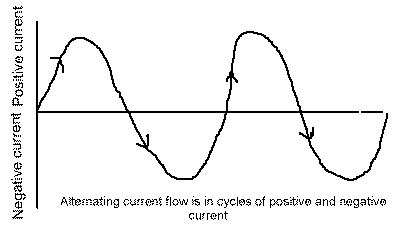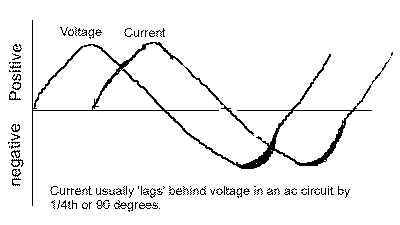
Conventionally, dc current is regarded as being from 'positive' to 'negative' of a battery or any other dc source (such as a dynamo). It is a 'stream' flow, just like the water flow in the hydraulic circuit, but the 'stream' is actually composed of sub-atomic particles or electrons. Unfortunately, after convention had established the 'positive to negative' flow definition it was found that this electron stream flow was actually from negative to positive. This does not matter for most practical purposes, but for an understanding of how transistors and other solid-state devices work it is necessary to appreciate this 'reverse' working.
'positive' always seems stronger than 'negative', so it is difficult to think of current as flowing other than from positive to negative. We can relate this to electrons flowing from negative to positive by thinking of electrons as particles of negative electricity. Being 'weaker' (neagative), they represent a 'reverse flow', setting up conditions for a postive flow of current - from postive to negative. Otherwise, simply forget the differnce and work on the practical fact that + and - are only terms of convenience used to ensure that components in a circuit which have positive and negative sides are connected right way round!. This applies mainly to batteries, transistors, diodes and electrolytic capacitors.
All materials are composed of atoms in which there is a stable balance of positive and negative charges (except in the atoms of radio-active elements). The application of an electrical pressure will cause electrons to be displaced fron the atom, leaving it with an effective positive charge. It is then in a state to sttract any stray electrons. Since there is electrical pressure present, this means that there will be a movement of electrons along the chain of atoms comprising the wiring and components(s) in the complete return circuit. It is this movement that constitutes the electric current flowing through the circuit, the strength of the current being dependent on the number of electrons passing any particular point in the circuit in a given time. Break the circuit and the 'pressure' is broken, so current flow ceases.
Atoms of materials like metals will give up electrons readily when subject to electrical pressure, and so are essentially non-conductors. If extremely resistant to giving up atoms, they are classified as insulators.
Summarizing, then, a dc circuit when connected or switched on provides a constant flow of current in one direction through the circuit, unless something changes in the circuit (e.g. source voltage changes, or a circuit resistance value alters). The value of this current is determined by hte sourde voltage and the total-resistance in the circuit. Current flow is also regarded as positive (or positive current).


Apart from the fact that ac is continually swinging from positive to negative current flow, the other difference compared with dc is that the actual current value present is also changing all the time. It does, however, have an 'average' value which can be defined in various ways. The usual one is the Root Mean Square (or rms) which is equal to .7071 times the maximum cycle values for sine wave ac such as normally generated by an alternator.
Another characteristic of ac is that both the voltage and current are continually changing in similar cycles. Only rarely, however, will the voltage and current both attain maximum and zero values at exactly the same time. The current curve is displaced relative to the voltage curve. This is called phase difference. It is normally expressed in terms of the ratio of actual displacement to a full cycle length on the zero line, multiplied by 360 (since a full cycle represents 360 degrees of ac working). This is called the phase angle. Usually the current will 'peak' after the voltage (i.e. be displaced to the right on the diagram), whereupon the current is said to be lagging and the phase angle is referred to as angle of lag.

Phase difference (phase angle) can be important factor in the design and working of many alternating current circuits because when a current 'lags' (or 'leads') the voltage, the 'timing' aspects of a circuit are affected.
